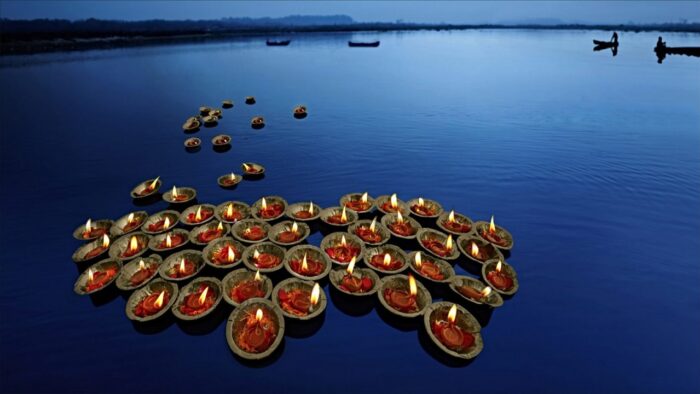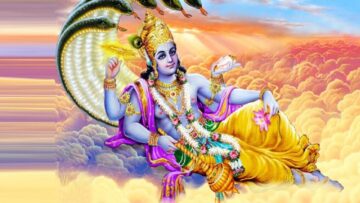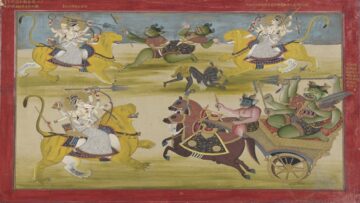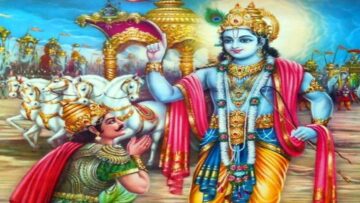Dharma is arguably the one word most commonly associated with Indic civilization. Few other Indian words are as readily associated with India as Dharma. Yoga and Karma probably come close to it.
But what is Dharma? It is a term that is poorly understood despite much overuse. It is often stated that India, at least in its idealized form, represents a “Dharmic” civilization. But what exactly is a “Dharmic” civilization? Does Dharma merely imply adherence to Hindu religion? Or is it linked to what is often called “the Hindu way of life”? If it is the latter, what is this “way of life”?
There are many questions about Dharma.
- Is Dharma “eternal” or “era specific”?
- Is Dharma contextual or context-free?
- Is Dharma synonymous with religion / faith or does it transcend religion?
- Is Dharma “law”? Or is it merely a set of guidelines that are non-binding?
It is often stated that there exists no appropriate translation of the word “Dharma” in English. It defies translation.
Be that as it may, this also begs the question – Is Dharma “definable” even in Indian discourse? Or does it have multiple definitions? Has the understanding of the term “Dharma” changed over millennia?
This essay is a modest attempt to understand Dharma as understood in traditional Indian literature (with a focus on the Hindu canon, as opposed to Buddhist canon)
Dharma: Its Etymology and use in early Vedic literature
First let us attempt to understand Dharma in etymological terms. Maybe there are clues to understanding it right there. In Classical Sanskrit, the word “Dharma” is derived from the root “dhr” which means “to hold / maintain”. But the word itself is very ancient and goes all the way back to the Saṃhitā section of Ṛg Veda. In the Ṛg Veda Saṃhitā, the word takes the form of “Dharman” which means “bearer / supporter”. This would suggest that Dharma refers to a certain set of ideals that help maintain “order”.
One can simplify this by associating the word with the hackneyed term “morality”. But Dharma transcends that. Not everything that is seemingly “moral” on the surface is necessarily sustainable or favorable to the maintenance of order. So the terms “sustenance” and “order” become key to understanding Dharma, right from its earliest usage in the Ṛg Veda.
The Ṛg Veda also discusses an allied concept called “ऋतम्” (ṛtaṃ) – which is associated with the cosmic principle that governs the universe. But the earliest layers of Vedic literature do not theorize on Dharma. We don’t get to understand the nature of social and personal conduct that constitutes Dharma.
This elaboration happens later in Indian history, first in the Upaniṣads, and then in the Itihāsas, the Bhagavad Gītā, and finally in the Dharma texts (Dharmasūtras and the successor Dharmaśāstras)
Dharma in the Upaniṣads
The Bṛhadāraṇyaka Upaniṣad seeks to define Dharma by linking it with “Truth”
स नैव व्यभवत् तच्छ्रेयो रूपमत्यसृजत धर्मम् ।
तदेतत्क्षत्रस्य क्षत्रं यद्धर्मस्तस्माद्धर्मात् परं नास्त्यथो
अबलीयान् बलीयाꣳसमाशꣳसते धर्मेण यथा राज्ञैवम् ।
यो वै स धर्मः सत्यं वै तत् तस्मात्सत्यं वदन्तमाहुर्धर्मं वदतीति धर्मं
वा वदन्तꣳ सत्यं वदतीत्येतद्ध्येवैतदुभयं भवति ॥ १४॥
(Part 1.4.14)
Here’s the translation from Swami Mādhavānanda of the Ramakrishna Math
“He projected that excellent form “righteousness” (Dharma). This righteousness is the controller of the Kshatriya. Therefore there is nothing higher than that. {So) even a. weak man hopes (to defeat) a stronger man through righteousness, as (one contending) with the king. That Righteousness is verily truth. Therefore they say about a person speaking of truth, ‘He speaks of righteousness,’ or about a person speaking of righteousness, ‘He speaks of truth,’ for both these are but the same”
What is evident is that the Upaniṣad here is clearly associating Dharma with the “Truth”. It is an elegant definition. However it does not elaborate on what the “Truth” might be, nor does it link the “Truth” with the sustenance of civilizational order, which we encountered in the Ṛg Veda Saṃhitā.
Further elaboration on what “Dharmic” conduct and “Dharmic” truth might mean is suggested in the Katha Upaniṣad where a contrast is drawn between what is “good” or “noble” (Shreyas) versus what is “pleasant” or “gratifying” (Preyas).
अन्यच्छ्रेयोऽन्यदुतैव प्रेयस्तेउभेनानार्थे पुरुषँसिनीतः ।
तयोः श्रेय आददानस्य साधु भवति हीयतेऽर्थाद्य उ प्रेयोवृणीते ॥ १॥
श्रेयश्च प्रेयश्च मनुष्यमेतः तौसम्परीत्य विविनक्ति धीरः ।
श्रेयोहि धीरोऽभि प्रेयसोवृणीते प्रेयोमन्दोयोगक्षेमाद्वृणीते ॥ २
(Verse 1.2.1 and 1.2.2)
Here’s the translation from Swami Paramānanda –
“Yama said: the good is one thing and the pleasant another. These two, having different ends, bind a man. It is well with him who chooses the good. He who chooses the pleasant misses the true end. The good and the pleasant approach man; the wise examines both and discriminates between them; the wise prefers the good to the pleasant, but the foolish man chooses the pleasant through love of bodily pleasure.”
So the Upaniṣads do associate Dharma with the pursuit of truth (Satyam) as well as the noble (Shreyas). But it is in the Itihāsa texts that these ideas were related to actual “real life” circumstances and problems, and there emerged a “context sensitive” understanding of Dharma.
The Itihāsas on Dharma – A discussion on “Context sensitivity”
In the Rāmāyaṇa, Dharma is viewed as the choice of “Shreyas” over “Preyas” (Doing the “right” thing over the “pleasing” thing) – two terms that we already encountered in the Katha Upaniṣad. The Rāmāyaṇa does not theorize a lot on Dharma, but instead chooses to define Dharma through the life example of Rama – a person who always chooses Shreyas over Preyas at every crucial juncture in the great epic.
The Mahābhārata, in contrast, is a major theoretical text, that discusses Dharma in considerable detail, particularly its two great sections – the Bhagavad Gītā and the Śānti Parva. The great epic offers a context-sensitive view of Dharma. Here are a couple of verses from the Gītā that allude to “Svadharma” where Dharma is linked to one’s circumstances
स्वधर्ममपि चावेक्ष्य न विकम्पितुमर्हसि।
धर्म्याद्धि युद्धाछ्रेयोऽन्यत्क्षत्रियस्य न विद्यते।।2.31।।
यदृच्छया चोपपन्नं स्वर्गद्वारमपावृतम्।
सुखिनः क्षत्रियाः पार्थ लभन्ते युद्धमीदृशम्।।2.32।।
Translation by Swami Mukundānanda
“Considering your duty as a Kshatriya, you should not waver. Indeed, for a Kshatriya, there is no better engagement than fighting for upholding righteousness (Dharma). Happy are the Kshatriyas to whom such opportunities to defend righteousness come unsought, opening for them the stairway to the celestial abodes”
The Gītā also suggests that one’s Svadharma is much more important than doing the duties of someone else.
श्रेयान्स्वधर्मो विगुणः परधर्मात्स्वनुष्ठितात्।
स्वभावनियतं कर्म कुर्वन्नाप्नोति किल्बिषम्।।18.47।।
सहजं कर्म कौन्तेय सदोषमपि न त्यजेत्।
सर्वारम्भा हि दोषेण धूमेनाग्निरिवावृताः।।18.48।।
Translation
“It is better to do one’s own dharma, even though imperfectly, than to do another’s dharma, even though perfectly. By doing one’s innate duties, a person does not incur sin. One should not abandon duties born of one’s nature, even if one sees defects in them, O son of Kunti. Indeed, all endeavors are veiled by some evil, as fire is by smoke.”
So what’s striking here in the Gītā is that, unlike in Upaniṣads, it positions Dharma not just with Satyam (truth) and Shreyas (goodness / virtue) but with the idea of duty. Duty is contextual and is specific to each person’s station and circumstance. Hence the approach to Dharma can never be “one size fits all”.
This acknowledgment of Dharma’s context-sensitivity and the impossibility of “defining” it is found even in the Āpastamba Dharmasūtra – one of the oldest Dharma texts. Āpastamba in these sūtras says –
“Dharma and Adharma do not go around saying, “That is us.” Neither do gods, nor gandharvas, nor ancestors declare what is Dharma and what is Adharma”
(Part 1.20.14; Translation : Patrick Olivelle)
This is an acknowledgment of Dharma’s enigmatic character.
However notwithstanding Dharma’s context sensitivity, it did not quite result in the Indian mind giving up on ‘defining’ Dharma. There was always a certain strand in Indian thought that argued that while Dharma may be “contextual” there are certain aspects to Dharma that are context-free and eternal.
This distinction came about in the Dharmaśāstra texts where the word “Sanātana Dharma” made its appearance.
Sanātana Dharma vs Yuga Dharma: Examining the Manu Smṛti
Sanātana Dharma literally means “Eternal Dharma” or “Eternal order” – which does make an interesting contrast to the “context specific” notion of Dharma we have discussed so far.
In fact during the age of the Dharmaśāstra, there emerged the distinction between Sanātana Dharma (which is eternal) and Yuga Dharma (which is specific to the age in which one finds onself). So Dharma can be both eternal as well as contextual.
To understand this best, let’s look at Manu Smṛti, the foremost of the Dharmaśāstra texts. Here is an instance of the use of “Sanātana Dharma” in Manu Smṛti –
सत्यम् ब्रूयात् प्रियम् ब्रूयात् न ब्रूयात् सत्यमप्रियम् |
प्रियम् नानृतं ब्रूयात् एष धर्मः सनातनः ||
(Verse 4.138)
Translation (Ganganath Jha):
“He shall say what is true; and he shall say what is agreeable; he shall not say what is true, but disagreeable; nor shall he say what is agreeable, but untrue; this is the eternal law (Sanātana Dharma)”
So while Dharma may have contextual usage, there are certain aspects to it (like the example given above by Manu) that transcend the vagaries of era and personal circumstance. There are aspects of it that are timeless.
However at the same time, Manu Smṛti does have many injunctions in it that, in my view, are best described as “Yuga Dharma” – strictures that belong to a certain era and are not necessarily applicable to all places and all times. Let’s take an instance of “Yuga Dharma” from this great text –
लशुनं गृञ्जनं चैव पलाण्डुं कवकानि च ।
अभक्ष्याणि द्विजातीनाममेध्यप्रभवानि च ॥ ५ ॥
(Verse 5.5)
Translation (Ganganath Jha):
“Garlic, leeks and onions, mushrooms and all that proceeds from impure things, are unfit to re eaten by twice-born men.”
So this amalgamation of Yuga Dharma and Sanātana Dharma makes Manu Smṛti a fascinating read. In Straussian terms, one can regard Manu Smṛti as a text that is both “Exoteric” and “Esoteric”.
- Exoteric : speaking to its own times
- Esoteric : speaking profound truths for eternity
Manu also makes a case for the inherent robustness of Dharma, as it can defend itself. Here’s the verse –
धर्म एव हतो हन्ति धर्मो रक्षति रक्षितः ।
तस्माद्धर्मो न हन्तव्यः मानो धर्मो हतोवाधीत् ॥
Here’s the translation, again from Ganganath Jha
“Dharma, blighted, blights; and Dharma, preserved, preserves; hence Dharma should not be blighted, lest blighted Dharma blights us”
Let’s not turn our attention to the Darśana literature. How does Yoga for instance consider Dharma?
Patañjali Yoga Sūtras: Dharma as a means of personal development
It is worth studying Patañjali in this regard, who wrote the famous Yoga Sūtras, the foundational text of Yoga. Patañjali is less abstract in his discussion of Dharma than the sources we have discussed so far. He is a man who likes details and defines Dharma in terms of “Yama” and “Niyama” – which are integral to “Dharma” and constitute two of the eight “limbs” of Yoga.
Patañjali suggests five restraints (Yamas) and five observances (Niyamas)
Yamas
- Ahiṃsā: Non-violence
- Satya: truthfulness
- Asteya: non-stealing
- Brahmacharya: chastity, marital fidelity, sexual restraint
- Aparigraha: non-possessiveness
Niyamas
- Śauca: Purity
- Santoṣa: Contentment
- Tapas: Austerity / meditation
- Svādhyāya: Self-reflection / study
- Īśvarapraṇidhāna: Contemplation of God
So clearly in Patañjali’s works we see a shift. Dharma is now increasingly studied from a reflective standpoint with a focus on personal growth in contrast to Dharma in the Gītā where it is more worldly and contextual.
If we study the ideas of several influential modern Indian thinkers like Vivekananda and even Gandhi in the 20th century, they are clearly influenced in a big way by the ideas of Dharma in Patañjali. Gandhian thought owes a great deal to the Yamas and Niyamas of Patañjali.
Dharma vs other Puruṣārthas
Next we need to ask the question – How did Dharma stack up against the other aspects of life in Indian thought?
Puruṣārtha is a word that comes up very early in Indian literature – as per which Dharma is only one of the four goals of a well led life (Artha, Kāma & Moksha being the other three). With the possible exception of Kautilya’s Arthashastra that privileges Artha, most Indian texts are unequivocal on this –
Dharma is paramount, and trumps Artha and Kāma
One of the votaries for Dharma is Vātsyāyana, a commentator on the Nyāya Sūtras from 5th century CE. Vātsyāyana is one of those rare Indian minds who explicitly distinguishes between Dharma and Adharma. In fact he goes one step further and distinguishes between the different types of Dharma and Adharma1
- Dharma / Adharma of mind (Kāyika)
- Dharma / Adharma of words (Vācika)
- Dharma / Adharma of body (Mānasika)
As per Vātsyāyana, “Paricharana” (rendering service to others) is “Dharma of the body” while “Pratisiddha Maithuna” (sexual indulgence that is unlawful / unnatural) is “Adharma of the body”
Vātsyāyana, who is quoted here, is not the same person who authored the Kāma Sūtras. Nevertheless we do see the Nyāya commentator here privileging Dharma over Kāma in unambiguous terms.
Dharma as a societal ideal: Varṇāśrama Dharma
So far we have discussed Dharma from a largely individual lens. But is there a societal view of Dharma voiced in the Hindu canon?
The answer is yes. This is best summed up by the well-known, yet controversial, phrase – “Varṇāśrama Dharma”. While Varṇa needs no introduction, Āśrama refers to the 4 stages of life – Brahmacharya (celibate student), Gr̥hastha (householder), Vanaprastha (retired life), and Saṃnyāsa (renounced life).
This societal view of Dharma (Varṇāśrama) is the aspect of Dharma that is most problematic in our times. This is partly because western liberalism privileges “individual liberty” as the highest ideal, and this conflicts with the Hindu emphasis on virtue, stability, and the notion that there is a “time and place for everything”. A fine example of this conflict is illustrated in the 2007 Bollywood movie Cheeni Kum where a 35 year old lady (played by actress Tabu) falls in love with and marries a 64 year old man (played by Amitabh Bachchan).
Is this consistent with Āśrama Dharma? Now let’s consider the original etymological understanding of Dharma where we started – “that which sustains / bears”. Is the kind of union described in Cheeni Kum sustainable for the society at large? It is worth pondering over. Yet when one uses the lens of “personal liberty” it is viewed unequivocally positively by modern liberal society.
Here is a fine instance where modern liberal morality can potentially conflict with Dharmic morality. While the Dharmic code focuses on behaviors and modes of thought that promote virtue and stability, modern liberalism privileges “liberty” as an end that trumps all other ends. These are two totally different takes on how to approach life.
As we look ahead into what remains of the 21st century, Indian society faces some hard questions:
How do we preserve Dharma? How do we balance it against the ideal of individual liberty (which has its charm, while often being inconsistent with the Dharmic ideal)? How do we have the cake and eat it too?
Maybe the answer lies in the Gītā and its linkage of Dharma with personal responsibility – the idea of Svadharma. Personal liberty can remain an ideal as long as individuals also face up to the consequences of the exercise of liberty.
To conclude it is fair to say that Dharma has been one of the core concepts of Indian religion, philosophy and social contract. It remains relevant in our times as India attempts to remain a “Dharmic” society notwithstanding the temptations of instant gratification and dereliction of personal virtue which often accompany modernity.
Notes
1 Classical Indian Ethical Thought : A Philosophical study of Hindu, Jaina and Bauddha Morals – Kedar Nath Tiwari, 1998
Featured Image: LPTI
(This article was published by IndiaFacts in 2018)
Disclaimer: The opinions expressed in this article belong to the author. Indic Today is neither responsible nor liable for the accuracy, completeness, suitability, or validity of any information in the article.










